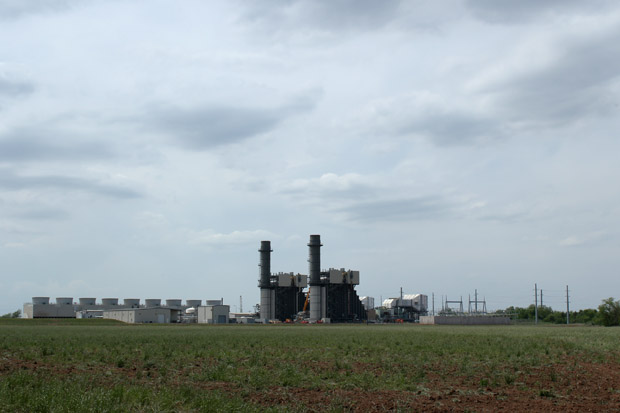
Oklahoma Gas and Electric's McClain Power Plant near Newcastle, Okla.
Joe Wertz / StateImpact Oklahoma


Oklahoma Gas and Electric's McClain Power Plant near Newcastle, Okla.
Joe Wertz / StateImpact Oklahoma

Joe Wertz / StateImpact Oklahoma
The McClain natural gas plant near Newcastle, Okla. is owned by Oklahoma Gas and Electric and the Oklahoma Municipal Power Authority.
Oklahoma has more natural gas reserves than all but three other states. And it now accounts for about 40 percent of the state’s power generation.
Hydroelectric and renewable sources— mainly wind — provide some too. But when you flip a light switch, chances are that electricity came from burning coal we get from Wyoming.
But new standards are forcing coal plants across the country to either shut down, or install scrubbers to limit the release of sulfur dioxide, and it’s changing Oklahoma’s energy mix.
Natural gas was once thought of as a very limited resource.
“The federal government mandated that utilities could no longer use natural gas as a boiler fuel,” Brian Alford, a spokesman for Oklahoma Gas and Electric, says. “At that time, the current thinking was that the U.S. was going to run out of natural gas. So, utilities needed to explore other options for generating electricity.”
So in the 1970s and 80s, several coal plants were installed. New technologies and research abilities have shown the state to be very rich in natural gas. Still, building new natural gas plants to replace coal, or installing scrubbers on existing coal plants is expensive.
A trip to CNG of OKC illustrates the point. Here, owner Josh Chapman converts vehicles that run on gasoline to run on compressed natural gas.
He says it costs around $8,000 to convert the average car or truck, before considering the big state tax credit that comes with the switch. Still, Chapman says he turns people away if he feels the costs outweigh the benefits for the customer.

Joe Wertz / StateImpact Oklahoma
Jeremy Helm (left) and Keith Marshall (right) install a compressed natural gas tank in a customer's truck at CNG of OKC.
If it costs that much to convert one vehicle to CNG, imagine the cost of replacing one of Oklahoma’s six major coal-fired power plants with natural gas.
“The costs associated on these fronts can be extraordinary,” Brian Alford, a spokesman for Oklahoma Gas and Electric, says. “If it was simply about managing for the environment, the answers would be very simple. But we also have to consider two other very important factors: The affordability of our product, and the other significant piece is reliability.”
A new gas plant can cost hundreds of millions of dollars. So can installing scrubbers at existing coal plants.
While OG&E fights the regulations in court, PSO has agreed to retire two of its units near Oologah by 2026. It’s difficult to say what all this means for your electric bill.